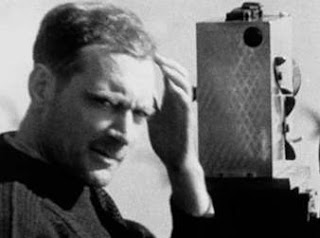4. What is Documentary Photography? [Week 2]
In this weeks lecture [October 12th], we looked at 'What Documentary Photography', to highlight it's importance, which should be obvious and known throughout this module.
Key Words : Truth, Objectivity, Issues, Information, People, Events, Reveal, Personal, Amateur, Record, Realism, Journalism, Passive Observers, Aesthetic, Primarly Historical Evidence/Context, Authenticity.
Most of these keywords were highlighted in our groups last week.
Can Be : A FORM, A GENRE, A TRADITION, A STYLE, A MOVEMENT.
 It's believed that the term 'Documentary' within Photography and film, was first used by a Dr John Grierson.
It's believed that the term 'Documentary' within Photography and film, was first used by a Dr John Grierson.
 'Night Mail' is one of Dr Greirson's most recognised Documentary Films, created in 1936, the film was meant to lift people's spirits during the recession. The film was created for social purposes, it made a drama out of the real, in order to keep the audience happy. It also documented the working class which was crucial to lifting the spirits. Even though it was classed as a true documentary film, there was one scene that included actors and also a script.
'Night Mail' is one of Dr Greirson's most recognised Documentary Films, created in 1936, the film was meant to lift people's spirits during the recession. The film was created for social purposes, it made a drama out of the real, in order to keep the audience happy. It also documented the working class which was crucial to lifting the spirits. Even though it was classed as a true documentary film, there was one scene that included actors and also a script.
Other Documentary Films...
Key Words : Truth, Objectivity, Issues, Information, People, Events, Reveal, Personal, Amateur, Record, Realism, Journalism, Passive Observers, Aesthetic, Primarly Historical Evidence/Context, Authenticity.
Most of these keywords were highlighted in our groups last week.
Can Be : A FORM, A GENRE, A TRADITION, A STYLE, A MOVEMENT.
'Has a special relationship to real life'
 It's believed that the term 'Documentary' within Photography and film, was first used by a Dr John Grierson.
It's believed that the term 'Documentary' within Photography and film, was first used by a Dr John Grierson.
He was (http://griersontrust.org) a prolific director and producer who influenced a brand new generation of documentary makers through his work with the Empire Marketing Board and the Post Office.
Other, perhaps more recognisable Documentary Movies include Dziga Vertov's 'Man with a Movie Camera' (1929), which documented the city life, and Robert Flaherty's 'Man of Aran' (1934). Flaherty's film is considered a 'Fictional Documentary', about the life on the Aran Islands off the Western Coast of Ireland.
Even though the term 'documentary' wasn't coined until 1926 by Dr Grierson, this doesn't mean that the documentary photographs didn't exist. Some documentary photographers included: Lewis Hine, Jacob Riis, William Henry Jackson, Roger Fenton, Matthew Brady, Paul Seawright (modern).
'Photojournalism' - is very closely linked to 'straight' Documentary Photography. It has a special relationship to the written word.
Timeliness - The images have meaning in the context of a recently published record of events.
Objectivity - The situation implied by the images is a fair and accurate representation of the events. They depict both content and tone.
Narrative - The images combine with other news elements to make facts relatable to the viewer or reader on a cultural level.
How our final definition on Documentary Photography would sound:
“A genre of photography that presents images in their purest form to comment upon areas of social or cultural significance. Not withstanding the problems of manipulation and notions of truth it aims to be factual, informative, fair and accurate. It is a genre that crosses many other disciplines within the history and cultural fabric of society and as a result is possibly indefinable”
 |
| P.H. Emmerson "Ricking the reed" from Life and Landscape on the Norfolk Broads, 1886 |
'Straight Photography' - refers to photography that attempts to depict a scene as realistically and objectively as permitted by the medium, renouncing the use of manipulation. It grew in the early 20th century in opposition to 'pictorialism', this included the works of Dr Henry Peter Emmerson.
- Unmanipulated Photographic Prints
- Higher Contrast
- Sharp Focus
- Aversion To Cropping
- Emphasis on the Underlying Abstract Geometric Structure of Subjects.
Timeliness - The images have meaning in the context of a recently published record of events.
Objectivity - The situation implied by the images is a fair and accurate representation of the events. They depict both content and tone.
Narrative - The images combine with other news elements to make facts relatable to the viewer or reader on a cultural level.
How our final definition on Documentary Photography would sound:
“A genre of photography that presents images in their purest form to comment upon areas of social or cultural significance. Not withstanding the problems of manipulation and notions of truth it aims to be factual, informative, fair and accurate. It is a genre that crosses many other disciplines within the history and cultural fabric of society and as a result is possibly indefinable”



Comments
Post a Comment